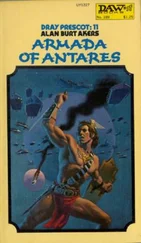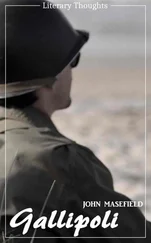The Turks naturally made no arrangements to defend this part of the coast, since it was inconceivable that an enemy force would land there, or, having landed, would be able to fight in such difficult ground. There is however a good beach just to the south. It runs for a mile or two in a shallow curve to the Gabe Tepe headland, and the country inland is much less broken. Here the Turks posted part of a battalion of infantry. This was not a strong force, but it was well dug in, and from Gaba Tepe the soldiers commanded a fair field of fire along the shore.
It was upon this beach that Hamilton directed his first attack for the conquest of the peninsula, very early on April 25.
Shortly after 2 a.m. three battleships, the Queen [12] Not to be confused with the Queen Elizabeth.
, Prince of Wales and London , reached their sea rendezvous off Gaba Tepe and stopped to lower their boats. The 1500 Australians who were to make the first assault assembled very quietly on deck. They had their last hot drink, and then, with their heavy packs on their backs and their rifles slung on their shoulders, they went down the Jacob’s ladders in the darkness. They sat tightly packed together in the boats, neither smoking nor talking, as they were towed on towards the shore. Presently they could see the dark smudge of the cliffs on the horizon ahead of them, and beyond this, reflected in the sky, the flash of the Turkish searchlights sweeping the Dardanelles on the other side of the peninsula.
At 4 a.m. when they were still 3,000 yards away, the tows were cast off, the black shapes of the battleships slid slowly astern, and a line of pinnaces, their engines sounding unnaturally loud, went on with the boats towards the shore. There was still no sign of life there. Once a signalman cried out, ‘There’s a light on the starboard bow.’ But it proved to be nothing more than a bright star and there was still no sound but the throbbing of the pinnace engines, the slow fall of the sea on the rocks. When they were within two or three hundred yards of the beach the pinnaces in their turn cast off, and the bluejackets took to the oars. The dawn was breaking.
The men had now been in the boats for several hours, their limbs had grown stiff and cramped, and the tension of waiting was becoming unbearable. It was inconceivable that they had not been seen. Suddenly a rocket soared up from the cliffs, and this was instantly followed by a sharp burst of rifle fire. Here finally was the moment for which they had been trained: the men jumped out of the boats and began wading the last fifty yards to the land. A few were hit, a few were dragged down by the weight of their packs and drowned, but the rest stumbled through the water to the beach. A group of Turks was running down the shore towards them. Forming themselves into a rough line and raising their absurd cry of ‘Imshi Yallah’ the Dominion soldiers fixed their bayonets and charged. Within a few minutes the enemy before them had dropped their rifles and fled. The Anzac legend had begun.
And now suddenly everything seemed to go wrong. The men had been told that they would find level ground and fairly easy going for the first few hundred yards inland from the beach. Instead of this an unknown cliff reached up before them, and as they hauled themselves upward, clutching at roots and boulders, kicking footholes into the rocks, a heavy fire came down on them from the heights above. Soon the air was filled with shouts and cries. Men kept losing their grip and tumbling down into gullies from which apparently there was no egress. Those who gained the first heights went charging off after the enemy and were quickly lost; and those who followed on behind, not knowing where to go, followed new paths of their own in other directions. Officers lost touch with their men, units became hopelessly mixed up and signals failed altogether.
Sunrise revealed a scene which had never been envisaged in Hamilton’s or anybody’s plans. Over an area of several thousand square yards a dozen isolated skirmishes were going on. Small groups of the Australians had penetrated inland for a mile or more; but most of the others were still pinned to the coast where they stumbled about among the rocks and the prickly scrub of the ravines. It was now apparent to everyone that they had not landed on the Gaba Tepe beach at all. In the darkness an uncharted current had swept the boats about a mile north of the intended landing-place and they were now in the midst of the moon landscape of the Sari Bair range.
The situation was almost as bewildering for the Turks as it was for the Dominion troops. They had made no plans whatever to meet this kind of attack. From the Gaba Tepe headland they still commanded the beach, and they drove back any of the Australians who attempted to come along it, but the small cove at which the boats had chanced to make their landfall was blocked from their field of fire and partly screened by jutting cliffs from the heights above. In the hills themselves there was no properly organized defence at all, and it was largely a matter of how far and how fast the Anzac troops could make their way over the tortuous ground — and in some cases this was very far and fast indeed. By 7 a.m. one young officer and two scouts had succeeded in climbing the first three ridges on the coast, and they were able to look down on the calm waters of the Narrows, only three and a half miles away, the object of the whole offensive. Another party was half way up the dominating peak of Chunuk Bair. By 8 a.m. eight thousand men had come ashore, and although there was great confusion everywhere it was clear that at many places the Turks were on the run. The horrors of the dark and the fear of facing bullets for the first time were now over, and an exuberant relief began to spread through the Anzac troops. The officers set about gathering them together for a more coherent advance.
It was at this point that Mustafa Kemal arrived. We have Kemal’s own account of his actions on this day, and there appears to be no reason to doubt his facts since they are confirmed by other people. Since dawn, he says, he had been standing by with his reserve division at Boghali in the neighbourhood of the Narrows, and it was not until 6.30 a.m. that he received an order to send off one battalion to meet the Anzac attack. The march from Boghali was slow and difficult, for the Turks themselves did not know this ground. Two guides who were sent on ahead got lost, and it was Kemal himself who, with a small compass and map in hand, found a way up to the crest of Sari Bair. From here he looked down and saw the warships and the transports in the sea below, but of the actual battle in the broken hills along the shore he could make out nothing at all. His troops were tired after the long hot march, and he gave orders for them to rest while he himself, accompanied by two or three officers, went forward on foot to get a better view. They had reached the slopes of Chunuk Bair when they saw a party of Turkish soldiers running towards them, evidently in full retreat. Kemal shouted to them to stop and asked them why they were running away. ‘Sir, the enemy.’ The men pointed down the hill, and at that moment a detachment of Australian soldiers emerged through the scrub. Already Kemal was a good deal nearer to them than to his own battalion, and he ordered the frightened soldiers about him to stand and fight. When they protested they had no ammunition he forced them to fix their bayonets and lie down in a line on the ground. Seeing this, the Australians also took cover, and while they hesitated Kemal sent his orderly officer running back to bring up his battalion which was waiting out of sight on the other side of the ridge.
In his report, Kemal remarks cryptically, ‘The moment of time that we gained was this one,’ and he goes on to describe how his battalion came up and drove the Australians from the hill.
Читать дальше












